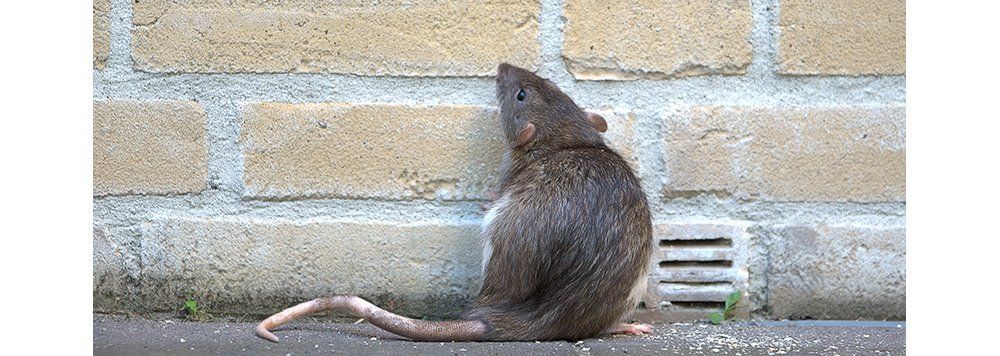RODENTS - MICE AND RATS
Rodents are very successful pests of our human environments owing to a combination of their impressive ability to adapt to new surroundings and reproductive capability. Rats and mice are linked to various zoonoses and it has been suggested that rat-borne diseases have taken more lives than all the wars ever fought. In the UK, there are three main species of rodent: the house mouse (Mus domesticus), the brown rat (Rattus norvegicus) and the black rat (Rattus rattus). However, numbers of the black rat have significantly reduced and presently these are only found in ports and indoor environments.
HOUSE MICE

• Colour: grey, brown, black
• Weight: usually up to 15g
• Length: about 6-9cm
• Distinctive features: tail is almost the same length as it’s body, pointed nose
• Droppings: rod shaped and about 3-6mm in length, approximately 80-120 per day
• Food: between 2-3g per day. Often, the moisture content of most foods is sufficient to sustain them and no additional water is needed.
o Sexual maturity: 1-2 months
o Litter size: 4-8
o Litters per year: 5-12
o Gestation: 19-20 days
o Weaning age: 18-21 days
Therefore, if left unabated, within 12 months one pair of breeding mice can produce 2000-2500 mice! Female mice can be pregnant, lactating and weaning three different litters of young at the same time and therefore, they are formidable at expanding their colony size!
These common pests of domestic and commercial properties are extremely efficient at commandeering an entire building once they have gained access. Their ability to rapidly infest an entire building, spreading vertically and horizontally throughout the building, is attributed to their small size, their curious nature, their ability to squeeze through extremely small spaces and their liking of unoccupied areas such as lofts/attics. Their success as a species is attributable to their close association with humans.
Mice are a pest species, causing food loss/spoilage and structural damage from gnawing, and a public health pest as a carrier of diseases albeit directly or indirectly. In urban areas, these diseases include lymphocytic choriomeningitis and leptospirosis (Weil’s Disease). Their faeces contain bacteria which may include salmonella, listeria and pseudomonas, and protozoan (microscopic animals) which may include cryptosporidium and toxoplasma. They have been known to spread toxoplasmosis (T. gondii) to humans as infected mice are often eaten by domestic cats which share our living space in our homes and this can have serious repercussions for pregnant women and those with reduced immunity capability. Furthermore, mice can exasperate allergens in people as studies of dust samples have shown, particularly in kitchen areas.
In view of their formidable breeding and disease carrying capability and their destructive nature, it is important to abate an infestation in the interests of your health and welfare. A small infestation is cheaper, quicker and easier to deal with than one which is left and allowed to multiply. Furthermore, it is an offence to allow an infestation to continue unabated on land where you live or that you own. This law was brought in many many years ago and ensures that we do not become overrun with these vermin because of their capacity to indiscriminately spread fatal diseases and consume vast quantities of food. Our expert technicians will advise on the best and most efficient strategy to eliminate the infestation effectively. This may involve a number of techniques depending on the circumstances. We will fully discuss any pest control treatment or techniques we recommend and what that will entail prior to starting works.
BROWN RAT

• Colour: grey brown
• Weight: 200-500g
• Length: up to 25cm
• Distinctive features: small eyes and ears, shorter tails – tails shorter than their body, 4 digits on front feet, 5 digits on rear feet
• Droppings: rod shaped and about 20mm in length, approximately 80-120 per day
• Vision: black and white vision - no colour vision
• Teeth: continually grow, extremely strong
• Food: prefer grains/grain-based foods but will adapt to any local source of food
o Sexual maturity: 2-3 months o Litter size: 7-8 o Litters per year: 5 o Gestation: 21-24 days o Weaning age: 21 days
Therefore, if left unabated, within 12 months one pair of breeding rats can produce 400-500 rats, therefore they are formidable at expanding their colony size!
Rats live in “clans” comprising their family or extended family. They are extremely well adapted to utilising their specific traits to their advantage to expand their colony size and prevent predation or extermination. They have poor eyesight, relying on their sense of “touch” and “smell”. The hairs on their body and muscle memory (kineasthesis) help them to memorise their territory as they brush up against and run alongside walls and structures and memorise the sequence of manoeuvres between their nest and food/water source. This strategy ensures they are less of a target from natural predators, such as birds, who are unable to swoop towards these structures and attack/predate them. Their heightened sense of suspicion of new and inferior objects (neophobia) ensure they avoid contact with rodenticides or other sources of potential harm. Their acute methods of self preservation which include early detection and association of feeling unwell with a particular food source containing a rodenticide, ensures that they avoid contact with that food source again and can make abatement problematic.
They are frequently found in drains and sewers, therefore they act as a reservoir of infection, carrying disease-causing organisms which can make humans very ill. Diseases caused by rats include Leptospirosis (Weil’s Disease), Streptobacillus moniliformis (Rat-Bite Fever), Salmonellosis – causative agent of Salmonella spp, Trichinosis – Trichinella, Murine Typhus fever – Rickettsia typhus, Plague – Yersinia (formerly Pasteurella) pestis – via fleas, Rickettsialpox – Rickettsia akari, and Lymphocytic Choriomeningitis. The food borne diseases caused by rats include the food poisoning bacteria, e-coli and campylobacter and the protozoan (microscopic animals) include Toxoplasmosis, Listeriosis, Cryptosporidium parvum and Hanta virus.
In view of their formidable breeding and disease carrying capability and their destructive nature, it is important to abate an infestation in the interests of your health and welfare. A small infestation is cheaper, quicker and easier to deal with than one which is left and allowed to multiply. Furthermore, it is an offence to allow an infestation to continue unabated on land where you live or that you own. This law was brought in many many years ago and ensures that we do not become overrun with these vermin because of their capacity to indiscriminately spread fatal diseases and consume vast quantities of food. Our expert technicians will advise on the best and most efficient strategy to eliminate the infestation effectively. This may involve a number of techniques depending on the circumstances. We will fully discuss any pest control treatment or techniques we recommend and what that will entail prior to starting works.
Role of the Local Authority and Responsibility of the Landowner/Occupier
The Local Authority has responsibility to keep the land within it’s boundaries free from rats and mice. The owner (or occupier) of land where an infestation is present has a legal duty to inform the Local Authority of the infestation and abate it at their own expense. It is an offence to allow an infestation to continue unabated and the Local Authority can serve a legal Notice requiring the owner (or occupier) to abate the infestation. As a company, we are conversant with these Notices and can provide pest control to abate the infestation and satisfy the requirements of the Notice. Talk to an expert today.



